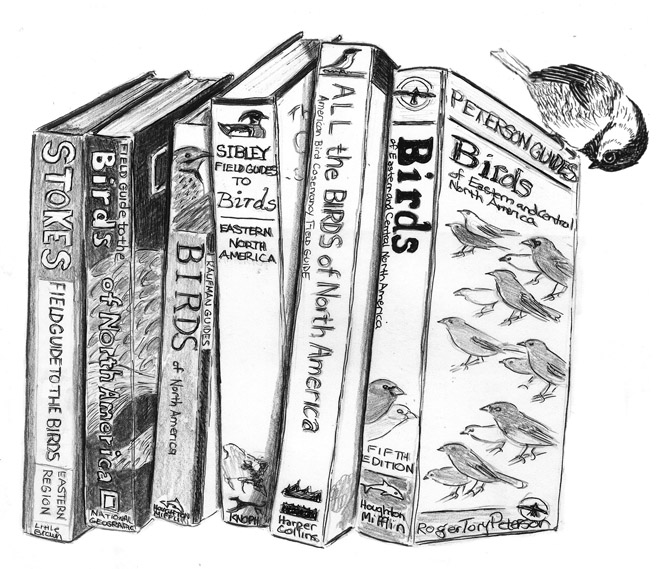
Dear Bird Folks,
We have several books to help us with bird identification, but none of them tell us much about their natural history. Can you suggest a book that also includes more information about birds?
– Cory, Truro, MA
Two books, Cory,
Instead of one, I can suggest two good bird books for you, and both were written by Massachusetts birders. And, if there’s room, I’ll mention a few more titles, also written by a Massachusetts chap. You may or may not know the first two writers, but I’m positive you’ll be familiar with the last guy. He’s been writing about Cape Cod birds for years and while he’s not nearly as brilliant as the other two, I think he’s better looking than they are, especially now that he’s wearing a mask all the time.
Last year, in the early stages of the pandemic, two excellent bird books were released, but neither got much attention. (Back then we were too focused on hand sanitizer and toilet paper.) The first book was written by famed author and illustrator, David Sibley. Although David was born in New York, he eventually smartened up and relocated to the Bay State. I’ve always been a fan of the late Roger Tory Peterson’s field guides because I appreciate the constancy of both his text and his illustrations. But in recent years, I’ve slowly moved to the Sibley camp. Bird identification can often be quite challenging and Sibley helps us by including several (sometimes as many as ten) images of the same bird on the same page. All these extra illustrations are great, but once we’ve figured out what bird we are looking at, it would be nice to know a little more about the particular species. This is why Sibley subsequently released, What It’s Like to Be a Bird and it’s pretty darned good.
Using his remarkable artistic skills, Sibley teaches us that the throat of a Ruby-throated Hummingbird isn’t, in fact, red at all, in spite of what we think we see. We also learn why robins cock their heads to one side when they are foraging (and no, they aren’t “listening” for worms). The tiny Golden-crowned Kinglet, according to Sibley, needs to eat the human equivalent of twenty-seven large pizzas per day in order to survive the winter’s cold. (Twenty-seven pizzas in a day? I think I’ve done that.)
What It’s Like to Be a Bird includes over 330 new illustrations and while they’re beautiful, they are also part of my only criticism. The book is hefty, almost coffee table size, and some of the images are larger than they need to be. I get the feeling the publisher decided to stretch things out a little in order to increase the size and price of the book. Don’t get me wrong; I love looking at the pictures (pictures are my favorite parts of books), but in this case more text and more information, or a lower price point might have made for a better product. This brings us to my second book suggestion and it checks all the boxes I just mentioned. The images (photos) are smaller, more numerous and there is considerably more information, a winning combination.
Unlike David Sibley, I doubt most folks have ever heard of John Kricher and that’s too bad. John is one of the most personable people you could ever meet, which can be a rare thing in the world of hardcore birding. The retired Wheaton College professor’s latest book, Reference Guide to Bird Behavior, part of the Peterson Series, is not the kind of book you might curl up with and read by the fire (although I do). Reading a “reference book” can be a little intimidating to some folks and I get it. I have shelves of reference books and I can’t understand half of what’s in most of them, but this is different. John taught college-aged kids (many with minimal bird interest) for forty-eight years and he knows how to make the subject both interesting and informative. Topics from migration, to mating, to birds standing on one leg (a behavior that really messes with peoples’ minds) are all discussed and clearly explained. Kricher avoids the use of confusing charts, equations and schematics that clog many of the other reference books on my shelf. In addition, his book is filled with hundreds of amazing photographs, which I frankly found to be inspiring. Seeing the vivid colors of, say, an Atlantic Puffin or a Painted Bunting makes me want to go out and do more bird watching. Conversely, looking at a bunch of equations and schematics makes me want to take a nap.
The third Massachusetts author I’d like to mention is the same guy who is writing this very column. His two books (Why do Bluebirds Hate Me? and Why Don’t Woodpeckers Get Headaches?) aren’t nearly as well illustrated as the previous titles we’ve discussed, but they are smaller, cheaper and easier to hold, and that has to count for something. More importantly, the books are a collection of questions asked by normal people and not just information researchers think we should know. They were written for those folks who aren’t overly serious about birds…or anything else in life.
Any of the books I’ve mentioned will be helpful, Cory, but if I were to pick one, I’d choose John Krisher’s Reference Guide to Bird Behavior. It’s excellent. Don’t worry; you won’t hurt my feelings if you choose either Sibley or Krisher over me. Their writing skills are far superior to mine, but at least I’m better looking…as long as I keep my mask on.